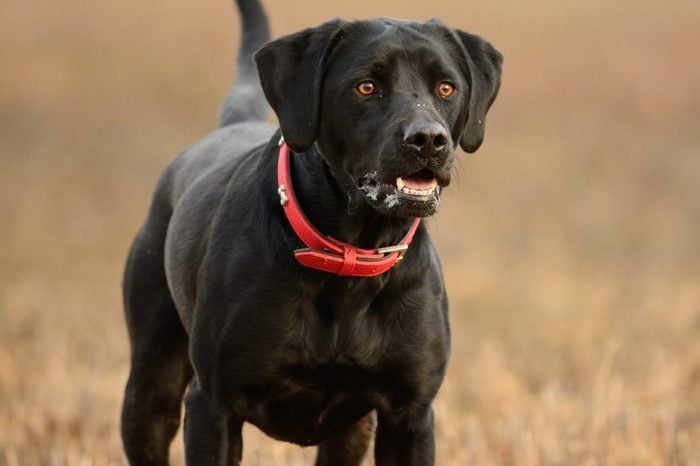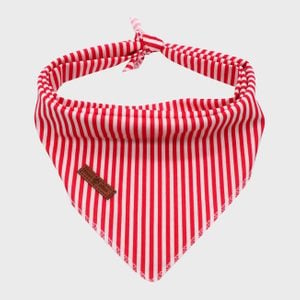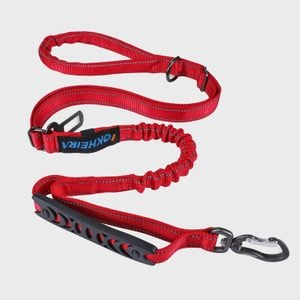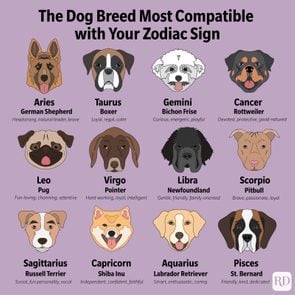If You See a Dog with a Red Collar, This Is What It Means
Updated: Mar. 22, 2024

Be on the lookout for these color-coded dog accessories.
Our editors and experts handpick every product we feature. We may earn a commission from your purchases.
When you see an adorable floof, it’s hard not to get a little giddy. They’re so cute with their flopping ears, doggy swagger, and hanging tongues! They obviously want some ear scratches and belly rubs, right? Not so fast.
Though petting a new pup may seem like a great way to meet your daily quota for endorphins, doing so isn’t always the best idea—especially if you see it wearing a red dog collar or bandana, or if it has a red leash.
We asked a couple of pet experts about red dog collars and what it might mean when a dog is sporting one of these bright red accessories. After learning this one, learn what it means when a dog licks you, why dogs put their paws on you, and why some dogs like to stare at you.
Get Reader’s Digest‘s Read Up newsletter for humor, cleaning, travel, tech and fun facts all week long
What does it mean when dogs wear a red collar or bandana?
Red is the universal sign for “stop.” We see it on stop signs and stoplights around the world. It’s a prominent color for police sirens and fire trucks, and we even use the color when talking about “red flags.” Red gives us reason to pause and be cautious, and it’s why some pups wear red dog collars or bandanas or use red leashes.
“Red is the signal that this pet is aggressive and needs space from both people and other animals,” explains Dr. Brian Evans, veterinarian and medical director of virtual vet care company Dutch. “These are pets that have been known to snap or bite at passersby, attack other dogs, or lunge at people. These pets may be perfectly fine at home with their owner but become overly protective of them when they are out.”
In some cases, red dog collars might also be worn by service or working dogs that shouldn’t be pet. Usually, they’ll have on a vest that says “service dog” or “emotional support,” which is often accompanied by a phrase like “Do not pet.”
That said, not all dog owners use this color-coded language. In the United States, we tend to see it more in professional settings. For example, Amy Shojai, a certified animal behavior consultant, notes that red dog collars are commonly used by the National Association of Canine Scent Work (NACSW). “The red bandana simply warns others to give the dog distance, yet allows the person and dog to participate in relative safety,” Shojai explains.
As a rule of thumb, it’s always best practice to use caution when approaching a new dog and to always ask permission before extending your hand. If the owner says they’d prefer you didn’t pet their dog, this is likely to protect you, the pup, and the owner. FYI, here are 13 things your dog wishes you’d stop doing.
What to do if you see a red dog collar, bandana, or leash
While not every potentially dangerous dog will have a red accessory—and not every red accessory worn necessarily means danger—always practice caution if you see a dog wearing this hue.
“It is not advised to attempt to ‘win over’ these animals,” advises Dr. Evans. He also suggests refraining from even asking to pet the dog if you see it’s wearing red. This can help avoid an uncomfortable interaction between you and the dog owner.
Ever wonder why your dog makes weird noises sometimes? Here are 10 noises your dog makes and what they mean.
More colors to know
Though color-coded leashes aren’t mainstream in the United States at this time, some dog owners do use the system. Color-coded accessories are also more popular abroad, so it’s good to be aware of them if you’re traveling.
Yellow
Yellow is typically reserved for pets that are nervous and may be unpredictable. While it’s not a full-blown “stop,” it’s definitely a “slow down,” just like with a yellow traffic light! Dr. Evans says, “These pets may have underlying fears or anxieties that have not been completely addressed and are not comfortable in certain scenarios.” Read on to find out what a yellow ribbon on a dog’s collar really mean.
Green
Green leashes signal that a pet is approachable for both people and other dogs. “However, you should never approach, pet, speak to, or interact with a strange dog before getting permission from the owner,” says Shojai. “That, I believe, remains the safest and most practical way to keep people—and the dogs we love—protected.”
Orange
Shojai says orange typically means that the dog doesn’t interact well with other dogs. Curb your own pup, cross the street, or pause to let the other dog pass calmly.
Blue
Blue vests, bandanas, and leashes are commonly used by service dogs, working dogs, or dogs in training. Many times, these accessories will even say “Do not pet.” As cute as the dogs are, you should avoid interactions and let the pup stick to their business. Nobody likes to be bothered when they’re hard at work!
Considering adopting a pooch for the first time? Here are the best dog breeds for first-time owners.
Sources:
- Dr. Brian Evans, veterinarian and medical director at Dutch
- Amy Shojai, a certified animal behavior consultant
- NACSW, Expectations for Dogs with Sensitivities as NACSW Events






